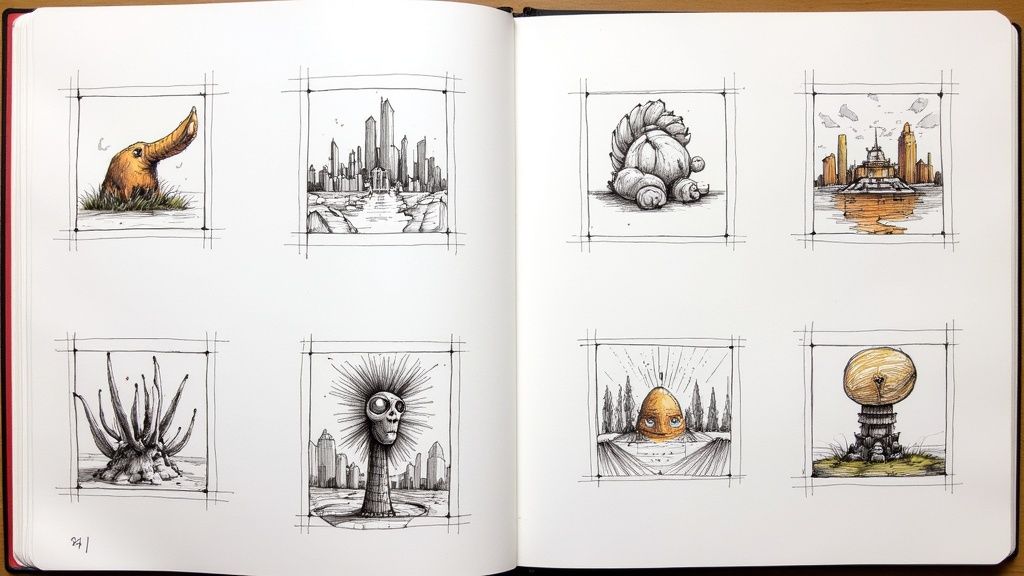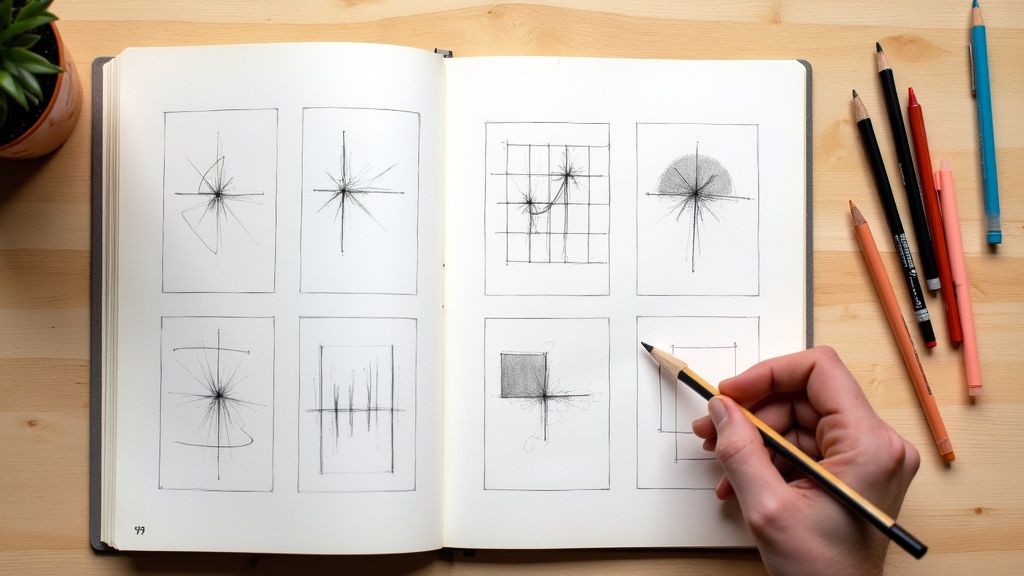Every artist, from the seasoned professional to the weekend hobbyist, has stared at a blank page, waiting for an idea that feels right. That moment of hesitation, often called 'artist's block,' can be frustrating, but it's not a sign of failure. It is an opportunity for a creative reset. A well-curated drawing prompts list is more than just a collection of random words; it's a powerful toolkit designed to push your boundaries, refine your skills, and reignite your passion for creating. Forget generic ideas that lead to uninspired sketches. We've moved beyond 'draw an apple' to explore prompts that challenge your perspective, storytelling, and technical abilities in fresh, exciting ways.
This guide provides a structured yet flexible drawing prompts list, organized into distinct thematic categories. Whether you want to master character design, experiment with abstract emotions, or tackle complex scenes, you'll find actionable starting points here. Each category is designed not just to give you an idea, but to equip you with specific tips, examples, and implementation strategies to make the most of every creative session. We will delve into ten powerful prompt types that will help you build a consistent drawing habit, develop a versatile portfolio, and, most importantly, have fun with the process. Let's transform that empty sketchbook page into a playground for your imagination.
1. Inktober Daily Drawing Challenges
Inktober is an internationally recognized, month-long drawing challenge that occurs every October. Created by artist Jake Parker, its core concept is simple: create one ink drawing every day for the entire month based on an official, single-word prompt. This structured approach is a powerful tool for building a consistent drawing habit and improving your inking skills. The global participation creates a massive, supportive community, making it one of the most popular items on any drawing prompts list.
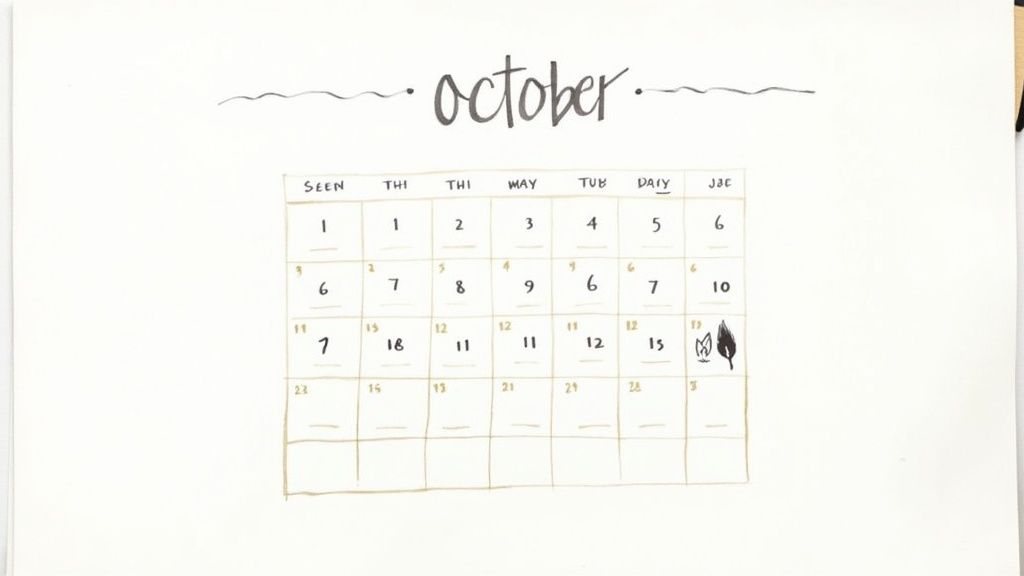
The official prompt list provides a unique theme for each day, such as 'Dream', 'Spiders', or 'Path'. This focused constraint removes the "what to draw" paralysis and pushes artists to interpret simple ideas in unique ways. By the end of the month, you have 31 new pieces that showcase your progress and creative evolution, which can be compiled into a powerful portfolio project.
How to Succeed with Inktober
To get the most out of the challenge, preparation and mindset are key. Focus on consistency over perfection.
- Gather Supplies Early: Before October 1st, assemble your tools. This could be anything from fine-liners and brush pens to traditional dip pens with India ink. Having them ready removes a daily barrier.
- Embrace Completion: The goal is to draw every day, not create a masterpiece each time. Some days you might only manage a quick sketch, and that’s perfectly fine.
- Engage with the Community: Share your work on social media using hashtags like #inktober and the current year's tag (e.g., #inktober2024). The feedback and encouragement from fellow artists are incredibly motivating.
This challenge is ideal for artists of any skill level looking to build discipline and connect with a global community. If the intensity of a month-long event appeals to you, you can explore other similar challenges. Discover more options by reading about daily drawing prompts that can help you stay creative year-round.
2. Character Design Prompts
Character design prompts are a fantastic way to move beyond generic figures and create truly original personas. Unlike single-word prompts, these often combine contrasting traits, professions, and settings to spark unique ideas. This approach, popular with concept artists at studios like Pixar and in communities like the Character Design Challenge, helps you build a narrative behind your art, making it a powerful tool in any drawing prompts list.
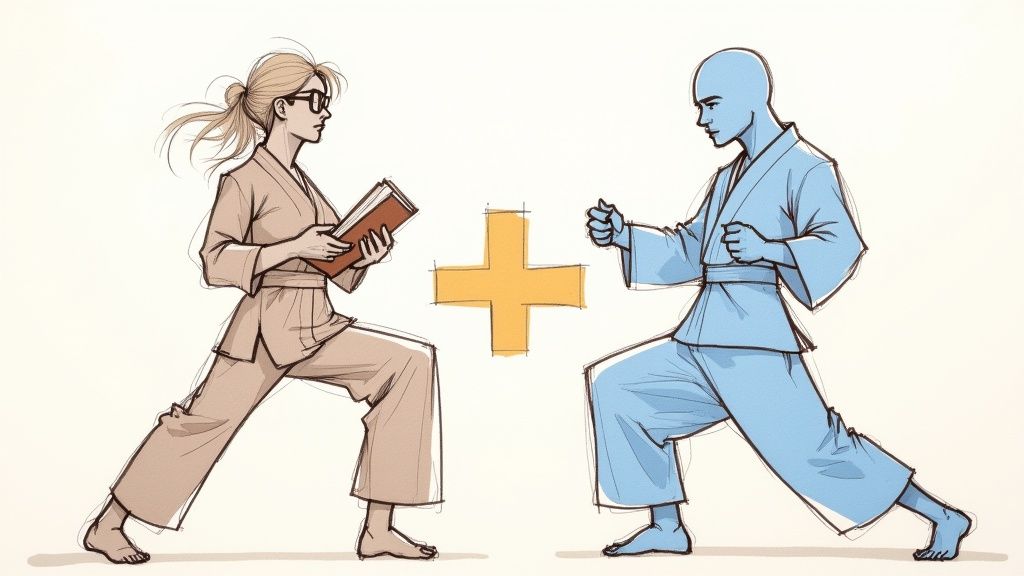
These prompts challenge you to solve a visual puzzle, such as 'a shy librarian who is secretly a skilled martial artist' or 'a robot baker from the 1920s collecting vintage postcards'. The goal is to visually communicate a character's backstory, personality, and world through their appearance, clothing, and props. This practice is essential for building a portfolio for animation, comics, or game design.
How to Succeed with Character Design Prompts
To create compelling characters, focus on story and structure rather than just aesthetics. A strong foundation will make your design more memorable.
- Focus on the Silhouette: Start by sketching simple shapes. A strong, recognizable silhouette makes a character instantly stand out, even before details are added.
- Research and Gather References: Look for real-world references for clothing, accessories, and environments related to your prompt. This adds authenticity and believability to your design.
- Tell a Story with Color: Use a deliberate color palette to reflect the character's personality. Warm, vibrant colors might suit an energetic hero, while muted, cool tones could suggest a more mysterious figure.
This prompt style is perfect for artists wanting to develop their storytelling skills and create a cast of unique individuals. To dive deeper into this creative exercise, you can explore a wide variety of character drawing prompts to get your imagination flowing.
3. Single-Word Inspiration Prompts
Single-word prompts are a minimalist approach to sparking creativity, offering maximum freedom by providing just one evocative term. The goal is to let your personal associations and imagination run wild, transforming a single concept into a full-fledged visual narrative. This method is a fantastic way to develop your conceptual thinking and is a simple yet powerful addition to any drawing prompts list.

This prompt style forces you to dig deep into what a word means to you. For example, 'Growth' could inspire drawings of plants, a growing city, or an abstract representation of personal development. Similarly, 'Velocity' might lead to a dynamic sketch of a speeding vehicle or an exploration of pure motion with lines and shapes. This flexibility allows for truly unique outcomes that reflect the artist's individual perspective.
How to Succeed with Single-Word Prompts
To get the most out of this minimalist approach, focus on quick ideation and personal interpretation.
- Brainstorm Associations: Before you draw, jot down the first 3-5 ideas that come to mind. This helps you move past the most obvious interpretations and explore deeper meanings.
- Embrace Abstraction: Don't feel tied to a literal depiction. Use the word as a jumping-off point for abstract shapes, colors, and textures that convey the feeling of the prompt.
- Set a Timer: To avoid overthinking, set a timer for 5-10 minutes. This encourages you to trust your instincts and commit to an idea quickly, which is great for warm-up exercises.
- Combine and Contrast: Try combining two random words to create a more complex and unexpected prompt, or pair a single word with a specific art style for a focused challenge.
This technique is perfect for artists who feel restricted by detailed prompts and want to strengthen their creative interpretation skills. It's an excellent tool for daily warm-ups or for breaking through a creative block.
4. Story-Based Scene Prompts
Story-based scene prompts move beyond single subjects to challenge artists with entire narratives. These prompts provide a specific scenario or moment, focusing on environmental storytelling, mood, and composition rather than just an isolated character. This approach, heavily used by concept artists in film and gaming, is excellent for developing a sense of place and atmosphere in your work, making it a valuable addition to any drawing prompts list.
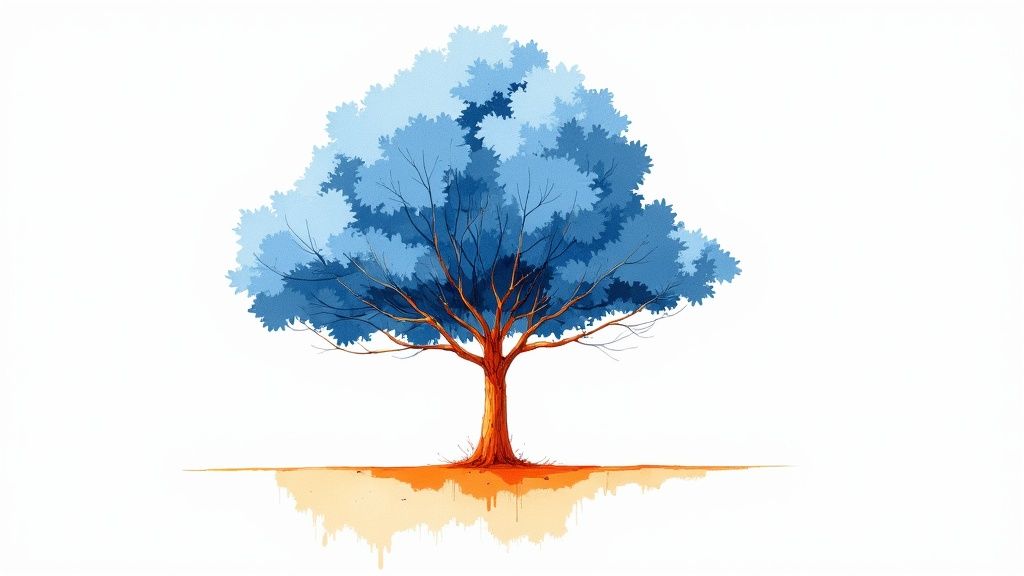
Prompts like 'An abandoned carnival at sunset with one remaining visitor' or 'A cozy coffee shop during a thunderstorm' force you to think like a director. You must consider lighting, camera angles, and what details to include or omit to best convey the story. This practice is fundamental for artists aspiring to work in storyboarding, environmental design, or creating evocative illustrations like those seen in Studio Ghibli films.
How to Succeed with Scene Prompts
To effectively tackle these narrative challenges, focus on planning and emotional impact. A strong composition is the foundation of a successful scene.
- Start with Thumbnails: Before committing to a full drawing, create several small, quick thumbnail sketches. This allows you to explore different compositions and camera angles without a large time investment.
- Focus on Mood Lighting: Use color temperature and light sources to establish the scene's emotional tone. Is the light warm and inviting or cold and desolate?
- Keep it Simple: Avoid overcrowding the scene with unnecessary details. A few well-chosen elements that support the core narrative will have more impact than a cluttered composition.
- Gather Your References: Use reference photos for architecture, props, and environmental textures to add realism and believability to your world.
This method is ideal for intermediate to advanced artists looking to improve their storytelling abilities and build a portfolio that demonstrates a strong understanding of composition and mood.
5. Emotion-Based Abstract Prompts
Emotion-based abstract prompts challenge artists to move beyond literal representation and translate internal feelings into visual language. Instead of drawing an object, you are tasked with capturing a mood, sensation, or psychological state using only color, line, and form. This method is excellent for developing intuition and is a cornerstone of any comprehensive drawing prompts list because it strengthens expressive skills.
The prompts are intentionally open-ended, such as 'The feeling of nostalgia', 'The sound of silence', or 'Overwhelming joy'. This encourages a direct connection between your inner state and the marks you make. An artist might represent 'anxiety' with chaotic, sharp, overlapping lines, while 'calm' could be depicted with soft, horizontal washes of cool colors. The final piece becomes a raw, visual diary entry.
How to Succeed with Abstract Emotion Prompts
To effectively translate feeling into art, focus on instinctual responses rather than detailed planning. Let the process guide you.
- Start with Color Associations: Before drawing, think about what colors you associate with the target emotion. For example, yellow for happiness or deep blue for melancholy. Let these initial choices guide your palette.
- Vary Your Mark-Making: Use different tools and techniques to convey feeling. Aggressive, fast scribbles can communicate anger, while soft, blended smudges might suggest wistfulness.
- Trust Your Intuition: The goal is not to create a recognizable image but to express a feeling. Avoid overthinking and allow your hand to move freely and intuitively across the page.
This approach is perfect for artists experiencing a creative block or who want to build a more personal and expressive style. If you want to dive deeper into this unique technique, you can explore more ideas for abstract emotion drawing to unlock new creative pathways.
6. Object Mashup Prompts
Object Mashup Prompts are a fantastic exercise in creative problem-solving, asking artists to combine two or more unrelated items into a single, cohesive design. This technique pushes beyond simple observation, challenging you to find visual and functional harmony between disparate concepts. By forcing you to think illogically, these prompts unlock innovative ideas and are a staple in any versatile drawing prompts list, especially for concept artists and designers.
The core challenge is to create a new object that feels intentional, not just two things awkwardly stuck together. For example, a prompt like 'combine a lighthouse with a coffee machine' could result in a tall, beacon-like percolator, or a prompt to 'merge a bicycle with a piano' might inspire a mobile instrument. These exercises are excellent for stretching your imagination and breaking out of creative ruts, leading to truly unique portfolio pieces.
How to Succeed with Object Mashups
To effectively merge two objects, focus on finding common ground and building a logical, albeit surreal, connection between them.
- Analyze Both Forms: Before drawing, quickly sketch or study the core shapes and functions of each object. Identify key features, textures, and mechanisms you can blend.
- Find a Unifying Element: Look for a shared purpose, shape, or design language. A cactus and a lamp, for instance, both have a base and an upward structure, providing a natural starting point for a fusion.
- Establish a Dominant Object: Decide which object will serve as the primary structure and which will provide the accent features. This helps create visual hierarchy and prevents the design from looking chaotic.
- Embrace the Absurd: Don't get too caught up in real-world physics. The goal is a visually compelling and imaginative creation. Think like a surrealist and let the combination guide your artistic choices.
This method is perfect for artists looking to enhance their design skills, develop a more imaginative style, and practice visual problem-solving. It's a foundational exercise used in industrial design and concept art to generate fresh ideas.
7. Time Period Fusion Prompts
Time Period Fusion Prompts challenge you to blend aesthetics, technologies, and cultural elements from different historical eras into a single, cohesive image. This approach, popular within genres like Steampunk and alternate history, encourages deep creative thinking and historical research. Instead of drawing one specific era, you create a new one by asking questions like, "What would a medieval knight look like with modern technology?"
This type of prompt pushes beyond simple object drawing and into the realm of speculative design and world-building. For example, you might illustrate a scene of Victorian-era aristocrats wearing clothing made from futuristic, self-cleaning textiles, or design a city where Ancient Roman architecture incorporates sleek Art Deco details. These prompts are a fantastic addition to any drawing prompts list because they build both imaginative and analytical skills.
How to Succeed with Time Period Fusion
Success lies in balancing the familiar elements of each era to create something that feels both new and believable.
- Research Both Eras: To blend two periods effectively, you must understand them individually. Spend time looking at references for architecture, fashion, and technology from each time. Museum archives are excellent resources.
- Focus on Key Visuals: Identify the most iconic visual elements of each period. For a Viking-meets-cyberpunk theme, you might combine Norse runes and braids with neon lights and cybernetic enhancements.
- Consider the 'Why': Think about the narrative behind your fusion. How did a Roman legionnaire get access to a laser rifle? This storytelling element adds depth and logic to your design, making it more compelling.
These prompts are perfect for artists looking to develop their concept art skills, create unique portfolio pieces, or simply explore "what if" scenarios in a visually engaging way. They are a powerful exercise in creative problem-solving and design.
8. Perspective and Angle Challenge Prompts
Perspective and Angle Challenge Prompts are a set of technical drawing exercises designed to improve an artist's understanding of space, form, and composition. Instead of focusing on what to draw, these prompts challenge how you draw it, pushing you to render familiar subjects from unusual, dramatic, or technically difficult viewpoints. This approach is highly effective for building foundational skills and mastering spatial representation.
These prompts ask you to tackle specific scenarios, such as 'Illustrate a kitchen from inside the refrigerator' or 'Draw a skyscraper from a worm's-eye view'. By forcing you out of your comfort zone, these challenges strengthen your ability to construct believable scenes and are invaluable for concept art, architectural illustration, and comic book creation. This technical focus makes them a crucial addition to any comprehensive drawing prompts list.
How to Succeed with Perspective Challenges
Mastering perspective is about understanding rules and then applying them creatively. A methodical approach is your best ally.
- Start with Simple Forms: Before drawing a complex cityscape, practice drawing simple cubes, spheres, and cylinders from various angles. This builds a strong foundation.
- Use Guidelines: Don't be afraid to use rulers and construction lines. Establish your horizon line and vanishing points first to ensure your scene is structurally sound.
- Break Down Complexity: When tackling a complex object like a car or a room, break it down into basic geometric shapes first. Draw the "box" the car fits in before adding details.
- Study References: Use photos and real-life observation to understand how angles and distance distort objects. Pay attention to how forms overlap and diminish in size.
This type of prompt is perfect for intermediate to advanced artists aiming to polish their technical skills or for beginners ready to move beyond flat drawings. They provide a clear path to creating dynamic and immersive artwork.
9. Color Palette Restriction Prompts
Color palette restriction prompts challenge artists to create compelling artwork using only a specific, limited set of colors. This method, long used by traditional painting masters and fine art academies, forces a deeper understanding of color theory, value, and composition. By removing unlimited color choices, you must solve visual problems creatively, often leading to more harmonious and impactful pieces. This approach is a fantastic addition to any drawing prompts list for artists looking to strengthen their color skills.
Prompts can be very specific, such as 'Draw a bustling market scene using only blues and oranges' or 'Create a portrait with a monochromatic purple palette'. The famous Zorn palette, which uses only four colors to achieve a full range of skin tones, is a classic example of this principle. These constraints encourage you to focus on how colors interact to create mood, depth, and focal points, rather than just what colors to pick.
How to Succeed with Color Palette Restrictions
To make the most of this challenge, focus on maximizing the potential of your limited colors. A strategic approach is more important than the specific palette.
- Study Color Relationships: Before you start, review basic color theory. Understand complementary, analogous, and triadic schemes. This knowledge will help you choose palettes that create natural harmony or intentional, high-impact contrast.
- Focus on Value and Saturation: With fewer hues, value (lightness and darkness) becomes your most powerful tool for creating form and depth. Explore the full range of saturation for each color, from muted tones to vibrant ones.
- Test Your Palette: Before committing to a final piece, create a small color chart or thumbnail sketch. Test how your chosen colors mix and look next to each other to avoid unexpected results.
This challenge is perfect for digital and traditional artists who want to move beyond default color choices and develop a more intentional, professional approach to their work. You can discover pre-made palettes or generate new ones using tools like Coolors to inspire your next drawing session.
10. Transformation Sequence Prompts
Transformation sequence prompts challenge artists to illustrate the gradual change of an object, character, or scene into something else across multiple stages. This method is directly tied to the core principles of animation and sequential art, making it an excellent exercise for developing storytelling and visual continuity skills. By breaking down a change into distinct steps, you train your brain to think about cause, effect, and the passage of time, a crucial skill in any narrative-driven drawing prompts list.
Popularized by animation studios and comic book artists, these prompts force you to consider the "in-between" moments. Examples include showing a flower blooming in six stages, a teapot morphing into a cat, or a character’s expression shifting from calm to enraged. Completing a sequence provides a set of related illustrations perfect for a portfolio piece that demonstrates technical skill and narrative thinking.
How to Succeed with Transformation Sequences
To effectively capture a transformation, planning and consistency are essential. Focus on making the transition believable.
- Plan the Key Poses: Before drawing, sketch out the beginning state, the end state, and at least one key midpoint. This creates a clear roadmap for the entire sequence.
- Maintain Consistent Elements: Keep certain features or background elements the same throughout the transformation to ground the viewer. This makes the changing parts stand out more effectively.
- Focus on a Single Change: To avoid overcomplicating the sequence, try to isolate one primary transformation. For instance, if a character is becoming a werewolf, first focus on the facial structure before moving to the body.
This prompt style is ideal for aspiring animators, storyboard artists, and comic creators who want to practice conveying motion and change over time. It offers a structured way to build a compelling visual narrative from a single concept.
Drawing Prompts Comparison Overview
Prompt Type | Implementation Complexity | Resource Requirements | Expected Outcomes | Ideal Use Cases | Key Advantages |
|---|---|---|---|---|---|
Inktober Daily Drawing Challenges | Moderate (daily for 31 days) | Ink supplies, daily time commitment | Improved ink skills, daily habit formation | Ink-focused skill building, social engagement | Structured prompts, strong community support |
Character Design Prompts | High (complex characters) | Anatomy knowledge, reference materials | Enhanced character design, storytelling | Animation, game design, illustration | Develops creativity and portfolio building |
Single-Word Inspiration Prompts | Low (simple, open-ended) | Minimal, any medium | Boost creativity, interpretive skills | Quick sketches, warm-ups, free expression | Maximum freedom, adaptable to all styles |
Story-Based Scene Prompts | High (complex scenes) | Reference photos, advanced composition skills | Improved storytelling, environment design | Concept art, illustration, storyboarding | Develops mood, lighting, and composition skills |
Emotion-Based Abstract Prompts | Moderate (abstract focus) | Any medium, emphasis on color & form | Emotional expression, abstract art confidence | Art therapy, experimental art | Encourages emotional exploration, stress relief |
Object Mashup Prompts | Moderate (creative combining) | Research on objects, design thinking | Innovative, surreal artwork | Product design, concept art | Stimulates creativity, problem-solving |
Time Period Fusion Prompts | High (requires research) | Historical resources, reference images | Unique artwork blending eras | Historical fiction, steampunk, alternate history | Builds cultural knowledge, detailed research |
Perspective and Angle Challenge Prompts | High (technical drawing focus) | Perspective knowledge, reference photos | Improved spatial reasoning and technical skills | Architecture, concept art, comics | Enhances technical and spatial drawing abilities |
Color Palette Restriction Prompts | Moderate (color constraint) | Understanding of color theory | Strong color theory application, harmony | Painting, digital art, design education | Develops color mixing and harmonious use |
Transformation Sequence Prompts | High (sequential, planned) | Planning tools, animation principles | Animation and storytelling skills | Animation, comics, storyboarding | Builds understanding of motion and pacing |
Making Prompts a Permanent Part of Your Creative Process
We've explored a wide-ranging drawing prompts list, from the narrative depth of story-based scenes to the technical rigor of perspective challenges. You've seen how single-word prompts can spark minimalist masterpieces and how object mashups can push the boundaries of your imagination. Each category, whether it's character design, color palette restrictions, or emotion-based abstracts, offers a unique pathway to unlocking your creative potential and systematically improving your artistic skills.
The true value of these prompts, however, isn't found in completing them just once. It lies in weaving them into the very fabric of your creative routine. Think of this list not as a one-time cure for artist's block, but as a versatile toolkit for sustained artistic growth. By consistently engaging with these ideas, you transform a blank page from a source of intimidation into a field of endless possibilities.
Actionable Strategies for Integrating Prompts
To make these concepts a permanent part of your artistic journey, you need a practical system. Consistency is far more impactful than intensity. Here are a few concrete methods to get started:
- The Daily Warm-Up: Dedicate the first 5-10 minutes of every drawing session to a quick prompt. Use a simple single-word prompt or a color palette challenge to activate your creative mind before moving on to larger, more complex projects.
- Themed Weekly Sprints: Focus on one type of prompt for an entire week. One week could be dedicated entirely to character design prompts, while the next focuses on perspective and angle challenges. This methodical approach allows you to build specific, targeted skills in a measurable way.
- The "Anti-Block" Sketchbook: Keep a separate, small sketchbook specifically for prompt-based work. This no-pressure environment encourages experimentation, allowing you to try new things like transformation sequences or time period fusions without the fear of "ruining" your main sketchbook.
Beyond the List: Building a Sustainable Creative Habit
Mastering the art of using prompts is about more than just finding ideas; it's about building a resilient and adaptable creative process. When you regularly challenge yourself with structured constraints and new concepts, you sharpen your problem-solving abilities, expand your visual library, and develop a more intuitive understanding of composition, form, and storytelling.
This practice ensures that you are always learning and evolving as an artist. You move beyond passively waiting for inspiration to strike and instead actively cultivate it. Every prompt, from the simplest to the most complex, is an opportunity to discover something new about your style, your preferences, and your capabilities. This proactive approach is the hallmark of a committed, flourishing artist. Embrace this drawing prompts list as your starting point and build a habit that will fuel your creativity for years to come.
Ready to turn these strategies into a daily habit with an endless supply of ideas? Explore the Drawing List ideas generator to access over 1,600 unique prompts across 99 categories, perfectly tailored to your interests. Find your next great idea right now at Drawing List.
